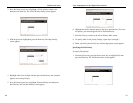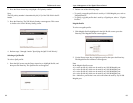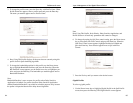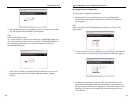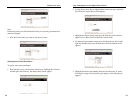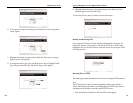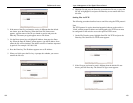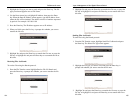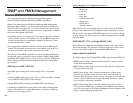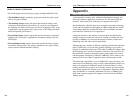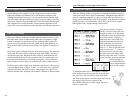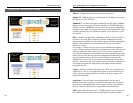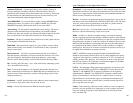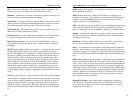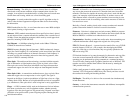
• Warm start
• Cold start
• Link up
• Link down
• Authentication failure
• Rising alarm
• Falling alarm
• Topology change
MIB-2 defines a set of manageable objects in various layers of the TCP/IP
protocol suites. MIB-2 covers all manageable objects from layer 1 to layer 4
and, as a result, is the major SNMP MIB supported by all vendors in the net-
working industry. The Switch supports a complete implementation of SNMP
Agent and MIB-2.
RMON MIB (RFC 1757) and Bridge MIB (RFC 1493)
The Switch provides hardware-based RMON counters in the switch chipset.
The switch manager CPU polls these counters periodically to collect the sta-
tistics in a format that complies with the RMON MIB definition.
RMON GROUPS SUPPORTED
The Switch supports the following RMON MIB groups defined in RFC1757:
• RMON Statistics Group maintains utilization and error statistics for the
switch port being monitored.
• RMON History Group gathers and stores periodic statistical samples from
the previous Statistics Group.
• RMON Alarm Group allows a network administrator to define alarm
thresholds for any MIB variable. An alarm can be associated with Low
Threshold, High Threshold, or both. A trigger can trigger an alarm when the
value of a specific MIB variable exceeds a threshold, falls below a thresh-
old, or exceeds or falls below a threshold.
• RMON Event Group allows a network administrator to define actions
based on alarms. SNMP Traps are generated when RMON Alarms are trig-
gered. The action taken in the Network Management Station depends on the
specific network management application.
107
Layer 2 Management 4-Port Gigabit Ethernet Switch
ProConnect II
®
Series
SNMP and RMON Management
This section describes the Switch’s Simple Network Management
Protocol (SNMP) and Remote Monitoring (RMON) capabilities.
RMON is an abbreviation for the Remote Monitoring MIB (Management
Information Base). RMON is a system defined by the Internet Engineering
Task Force (IETF) document RFC 1757, which defines how networks can be
monitored remotely. RMONs typically consist of two components: an RMON
probe and a management workstation:
• The RMON probe is an intelligent device or software agent that continually
collects statistics about a LAN segment or VLAN. The RMON probe trans-
fers the collected data to a management workstation on request or when a
pre-defined threshold is reached.
• The management workstation collects the statistics that the RMON probe
gathers The workstation can reside on the same network as the probe, or it
can have an in-band or out-of-band connection to the probe.
The Switch provides RMON capabilities that allow network administrators to
set parameters and view statistical counters defined in MIB-II, Bridge MIB,
and RMON MIB. RMON activities are performed at a Network Management
Station running an SNMP network management application with graphical
user interface.
SNMP Agent and MIB-2 (RFC1213)
The SNMP Agent running on the switch manager CPU is responsible
for:
• Retrieving MIB counters from various layers of software modules according
to the SNMP GET/GET NEXT frame messages.
• Setting MIB variables according to the SNMP SET frame message.
• Generating an SNMP TRAP frame message to the Network Management
Station if the threshold of a certain MIB counter is reached or if other trap
conditions (see next page) are met:
106
Overview



